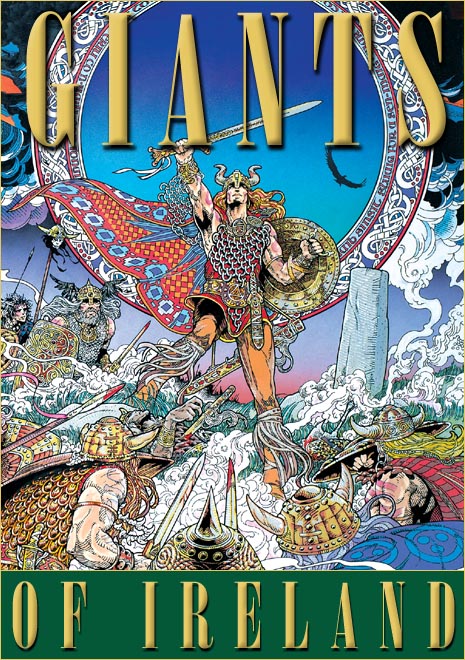
Editorial
|
Press Releases
|
Book Reviews
|
Fragments
Artifacts: The Exodus Revelation I
The Journey: Ireland I
|
Giants of Ireland
|
The Lord of the Rings Cipher I
Register
for our Hall of Records Newsletter
Questions? Comments? Suggestions? Advertising? Press Releases?
Contact us!
The Sons of Magog
|
Giants of Ireland
|
The Quest Continues
Giant Links
|
Books
|
Audio
|
Video
|
Posters
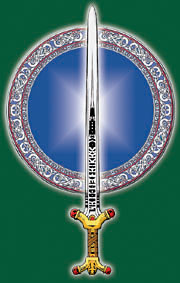
|
|
The Claimh Solais, "The Sword of Light", the powerful
magical sword that Nuada, King of the Tuatha d� Danann, used in
both battles of Moy Tura. It is said that when it was drawn from its battle
scabbard, none could stand against it. Is it possible the Claimh Solais was actually a high technology weapon, the like of which we are only now beginning to understand?
Image � 1978, Jim Fitzpatrick.
|
|
|
|
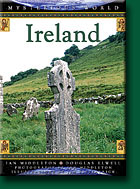
|
|
|
This article is adapted from
Mysterious World: Ireland,
the first in a series of guidebooks published by Mysterious World Press.
Click here to learn more about the mysterious giants of Ireland, and much more!
|
 n our previous series on
Giants,
Parts
I,
II,
III
and
IV,
we explored the history and mystery of the "giants in the earth" mentioned in
Genesis 6
and elsewhere in the Bible, as well as in numerous ancient texts and traditions from around the world.
Furthermore, we analyzed how history shows that these ancient "men of renown" did indeed exist, and had attempted not once but twice to conquer the world and destroy the lesser, weaker, homo sapiens form of mankind — i.e., us — and dominate the world. And, to some extent, we also looked at specific tribes of giants to be found throughout the world, and even some individual giants whose names and fame survive to this day.
n our previous series on
Giants,
Parts
I,
II,
III
and
IV,
we explored the history and mystery of the "giants in the earth" mentioned in
Genesis 6
and elsewhere in the Bible, as well as in numerous ancient texts and traditions from around the world.
Furthermore, we analyzed how history shows that these ancient "men of renown" did indeed exist, and had attempted not once but twice to conquer the world and destroy the lesser, weaker, homo sapiens form of mankind — i.e., us — and dominate the world. And, to some extent, we also looked at specific tribes of giants to be found throughout the world, and even some individual giants whose names and fame survive to this day.
However, most of the ancient peoples whose legends still remember the giants have long since forgotten their names, to the point where many of the
legendary exploits of these ancient men of renown have long been forgotten. And of those giants whose names and fame were great enough to be remembered, only a handful are still recalled in the histories, myths and legends of the world.
The giant kings
Sihon.
Og
and
Goliath
of the Bible, the
Cimmerian
giant
Acmon
and his son Doeas (ancient giant kings whom some believe were the inspiration for the titans of Greek mythology),
and of course the historical giants
Maximinus,
the Roman Emperor and
Maximilian,
Emperor of the Holy Roman Empire are among the handful of names still recalled out of the many millions of these "giants in the Earth" under whose mighty feet the world once trembled.
But there is one country that still recalls its ancient, giant past with a fair degree of clarity:
Ireland.
Invaded by wave after wave of giants from central Asia over thousands of years, Ireland's mysterious history is replete with tales of giants, fairies, gods and demons, swords and sorcery unlike any other nation in the world. Moreover, unlike most other countries of the ancient world, Ireland still remembers where its ancient ancestors originated:
Central Asia,
the ancient homeland of the giants.

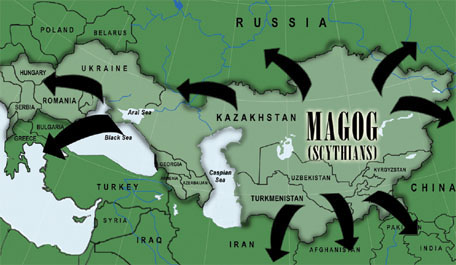
|
Though the sons of Magog originally were allotted the lands of what is now Central
Asia, they became a wandering, conquering people, driving the sons of Gomer west into
Central Europe, adding what is now southern Russia and Eastern Europe into their
domain. They also invaded north, east and south, influencing the development of
numerous Asian, Near Eastern and European cultures including parts of France, Spain
and eventually Ireland, which they invaded from the sea via Spain. For more information
on the giant sons of Magog, see our groundbreaking essay on the subject at
http://www.mysteriousworld.com/Journal/2003/Autumn/Giants/.
Image � 2006 Mysterious World.
|
Genesis chapter 10 contains a very interesting and controversial list of the descendants of Noah called
"The Table of Nations".
In this listing, all of the early descendants of Noah through his sons Shem, Ham and Japheth are listed, with little commentary on the fate of the nations that they had sired. Thus, it has been the duty of scholarship to piece together and maintain the puzzle of our ancient past � of who migrated where, when, and why. Of special interest to our present study, however, is an understanding of the lineage of Japheth, specifically, his second son,
Magog.
The territory allotted to Magog after the Flood was the region north and east of the Caucasus, covering what is now southern Russia and the Central Asian republics to the east. In ancient times, control of this vast region had been fought over by the descendants of Gomer, the
Gomerians
(better known to history as the "Cimmerians")
and the descendants of Magog, who in historic times were referred to by the Greeks as the "Scythians". The Scythians were a race of superb horsemen and archers, who had forced the Gomerians to emigrate into Europe around 700 b.c., and remained in the region to become the southern Russians and related Central Asian peoples.1 These, wandering, conquering people were the terror of the ancient world, their migrations taking them all the way across Europe even as far as Ireland (and possibly as far as North America), the mysterious island of the West that would come to figure prominently in the destiny of the sons of Magog.

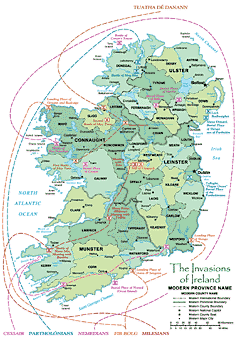
|
|
|
Irish history records six major invasions including the Cessair (a pre-flood invader) and five Magogian peoples: The Partholonians, the Nemedians, the Fir Bolg, the Tuatha de Danann and the Milesians. Click here to download a free invasions map from our new guide to Ireland,
Mysterious World: Ireland.
|
|
According to the primary ancient
historical text of Ireland, the Lebor Gabala �renn, �The Book of the
Invasions of Ireland�, there were a total of 5 peoples who invaded Ireland
before the coming of the Gael: the Cessair, the Parthol�nians, the
Nemedians, the Fir Bolg and the Tuatha d� Danann. The Milesians were
the final invaders recorded in the Lebor and are considered to be the first of
the Gaelic peoples to inhabit Ireland. However, though only the Milesians
were considered to be true Gaels, all of these invading peoples � save the
Cessair � were related to the Milesians, as they were all descendants of
Magog, the son of Japheth, the son of Noah. As it says in the Lebor,
Magog, of him are the men of Scythia and the Goths, that is, the
Gaedil. Magog had five sons, Baath, Ibath, Barachan, Emoth,
Aithechta. As for Baath, his son was Feinius Farsaid, father of the
Scythians. As for Feinius Farsaid, he was son of Baath s. Magog s.
Iafeth [Japheth]. As for Ibath, one of the two sons of Magog, his son
was Alainus. He had three sons, Airmen, Negua, Isicon. Airmen
had five sons, Gotus, Uiligotus, Cebitus, Burgandus, Longbardus.
Negua had four sons, Vandalus, Saxus, Bogardus, Longbardus.
Isicon, the third son of Alainus, had [five] sons, Francus, Romanus,
Albanus, a quo Albania in Asia Minor, and Albanactus ... a quo
western Alba, and Britus, from whom are called the
islands of Britain. Then was the world divided into
three divisions: Europe, Africa, Asia. Seventeen
years before the scattering of the languages there
came the first man of the seed of Iafeth into Europe, Alainus s.
Ibath s. Magog s. Iafeth s. Noe. Alainius, of him are the Franks and
the Romans. And his three sons came with him, Armen, Negua,
Isicon: so that on the hither side they begat those sons of whom we
have heard: Saxus s. Negua s. Alainus s. Ibath s. Magog s. Iafeth s.
Noe, of him are the Saxons. Emoth s. Magog, of him is the people
of the north of the world. Barachan [was another son of Magog].
Aithechtaig s. Magog, of his progeny are the peoples who came
into Ireland before the Gaedil � Parthol�n [was the first]. Nemed
was of the family of the son whom Parthol�n left in
the east, Adla s. Parthol�n. Also the children of
Nemed, the Gaileoin and Fir Bolg and Fir
Domnann and Tuatha d� Danann.2
The descendants of Magog, though not elucidated in Genesis 10, are
fully laid out in the Lebor Gabala, as the inhabitants of Ireland are
primarily of Magogian ancestry. Magog, according to the Lebor, had
five sons, from whom proceeded the Scythians, the Gaels, and
numerous other Central Asian and European peoples of note whose
allotted lands were originally what is now Central Asia. However,
they had greatly increased their lands through conquest so that the
descendants of Magog at their peak occupied a wide band of territory
that bordered on the north with what is now Central Europe and
Russia, on the south with what is now Italy, Greece, Turkey,
Armenia, Iran, Afghanistan, Pakistan and India, on the east with
what is now China and on the west with the
Atlantic Ocean. It is in these lands where the sons
of Magog finally settled.

|
|
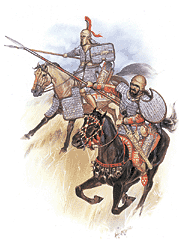
|
|
|
The Irish are largely descended from the
Scythians, a warlike people based in Central
Asia who conquered much of the civilized
world in ancient times, including parts of
Asia, the Near East, Russia, and parts of
Europe as far west as Ireland. Artwork by
Angus McBride, from MAA 137: The
Scythians: 700-300 BC, � Osprey Publishing
(www.ospreypublishing.com)
|
Though the descendants of
Magog included such prominent
peoples as the French, the Romans
and the Russians, most relevant to
our present study were the
Scythians � a magnificent race of
tall, Caucasian, blonde and redhaired
warriors who, along with
their ancient ancestors, had dominated
the Central Asian steppe for
thousands of years. The Scythians
were best known for being the first
people to not only domesticate the
horse, but also to use it effectively
in battle, either under a saddle or
pulling a chariot. They were also
well known for their use of the
composite bow, which they would
shoot over the backs of their horses
as they feigned retreat, much
like the classic �Parthian Shot�
maneuver of the later Parthians. In
appearance the typical Scythian
could easily pass for a typical Scot or Gael, except they were taller and
broader, and wore lots of gold. Otherwise they were nearly identical, right
down to the brightly colored tartan-style fabrics and use of breeches, an
innovative trouser-like clothing style they themselves had invented to
make riding on horseback easier. Most of all they loved their horses. And
they had good reason to, as it was from horseback that the Scythians conquered
far and wide, becoming the terror of the civilized world.
However, despite their barbaric tendencies, which included such
practices as tattooing themselves from head to toe
and using the gold-plated, hollowed-out skulls of
their defeated enemies as drinking vessels, they were also capable of civilized behavior, having developed extensive
trade networks stretching all the way from Europe to China.
Basirov explains,
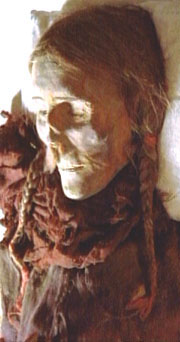
|
|
|
This mummy of a 40-year-old, tall,
Caucasian red-headed woman was found in
the Taklamakan Desert in western China in
the late 1980s. Dressed in tartan plaid and
displaying distinctly Caucasian features, the
Taklamakan mummies reveal a missing link
in our understanding of the history of the
ancient Scythians, and of the Gaels. Image
from Nova, �Mysterious Mummies of
China�. Copyright � 1998 WGBH/Boston.
|
|
The Scythians were known by the Achaemenians as SAKA
and SKUDRA, by the Greeks,
SKYTHIA, by the Romans,
SCYTHIAE (pron. SKITYAI),
which has given us the
English word SCYTHIAN;
they lived in a wide area stretching
from the south and
west of the River Danube to
the eastern and northeastern
edges of the Taklamakan
Desert in China; this vast territory
includes now parts of
Central Europe, the eastern
half of the Balkans, the
Ukraine, northern Caucasus,
southern Russia, southern
Siberia, Central Asia and
western China. We know a
great deal about their physical
appearance; they were
long-headed giants with
blond hair and blue eyes; this
well-known fact is attested
by various classical sources,
and by their skeletal and
other remains in numerous
archaeological excavations,
which give a fairly detailed
description of
these ancient
Iranians; recently, a large number of their mummified corpses were
discovered in western China; these mummies, which are
extremely well-preserved in the arid conditions of the
Taklamakan desert, are now on display at the museums of
Khotan, Urumchi, and Turfan in Sinkiang; they are dressed in
Scythian costume, i.e., leather tunic and trousers, and are usually
displayed in the sitting position, exactly as described by
Herodotus; what is extraordinary apart from their northern
European features, however, is their gigantic heights, well over
two metres as they are now, in spite of the natural shrinkage
expected during the past thousands of years.3
Though the contributions of these �giants in the Earth�4 are routinely
downplayed or even ignored by historians, the Scythians and related
Magogian peoples in fact played a major role in the evolution of the histories
of both Europe and Asia. Their invasions led them to conquer and
rule over numerous nearby countries during various periods, including
Eastern Europe, Egypt, Canaan, Babylon, Persia, Afghanistan, China
and especially India, whose ancient history is full of stories of tall,
blonde, Caucasian, chariot-riding giants conquering and forming ruling
dynasties over the native populace. And though an analysis of the history
and conquests of the Scythians could easily fill several volumes, most
important to our present discussion is their conflict with their cousins to
the west, the Gomerians, better known to history as the �Cimmerians�.

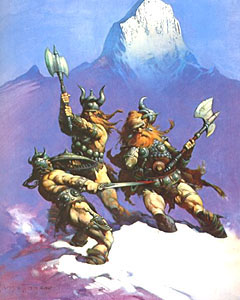
|
|
"Snow Giants" � Frank Frazetta. Frazetta was apparently inspired by the Robert E. Howard Conan the Cimmerian short story, "The Frost Giant's Daughter", where Conan fought twin giants who were blocking his pursuit of the exceptionally beautiful daughter of the Frost Giant King. As we have discovered in previous articles on the giants in the earth, the ancient Celts universally worshiped twin deities. Could it be that Gomer ("Gog") and Magog, the two eldest sons of Japheth, were in fact giant twins? Could that be a mystery that Howard had discovered, that he was trying to communicate through his story?
Click here to purchase an art print.
|
|
According to
Genesis 10:2,
Magog had an older brother named
�Gomer�. Gomer�s hordes initially occupied what is now Greece,
Turkey, Armenia, and parts of the ancient Near East, eventually becoming
known to history as the �Cimmerians�.
Like Magog�s descendants,
some of Gomer�s descendants also migrated northward, occupying the
lands west of Magog�s lands in and around what is now known as the
Ukraine. However, conflict arose between the descendants of the two
brothers, the Gomerians and the Magogians, and the
Magogians won, driving the northern branch of the
Gomerians that had lived in the Ukraine further west into Central Europe where they later became known as the
�Germans�. There, the fierce �Germani� tribes and their Gallic
cousins would eventually bring mighty Rome to her knees � but that
is a story for another time.5
This conflict between the descendants of Gomer, or �Gog�, and of
Magog appears to have been the central conflict that set the tone for the
history of
Eurasia
for thousands of years, a conflict that played itself out
in numerous wars and rumors of wars throughout Asian and European
history. This struggle between the two warring brothers, Gog and Magog,
made itself known most clearly in the battles for the control of Ireland.
There, the Gomerians would forever become enshrined in Irish legends
as the �Fomorians�, a race of giant, brutal barbarians based in what is
now central and northern Europe that routinely invaded and plundered
not only Ireland, but all of the British Isles.
The Parthol�nians, a tribe of Magogians listed in the Lebor as the
second people to have invaded and settled Ireland in ancient times,
are said to have had to drive out the Fomorians before they could do
so. It is interesting to note that even though the Fomorians had in fact
invaded and occupied Ireland for a time before the coming of the
Parthol�nians, they were not given the same status of the other
invaders that are listed in the Lebor, instead being denigrated to the
level of a dark, dangerous, almost demonic infestation that the
Parthol�nians had been sent by higher powers to cleanse the land of �
an infestation that seems to have been considered to be the very
antithesis of life, light and civilization. As Marie-Louise Sjoestedt
explains in her critical work, Celtic Gods & Heroes,
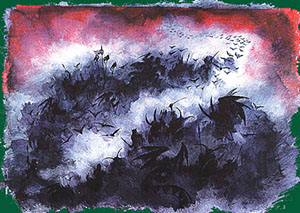
|
|
�Fomor Shapechangers� � 1992, Jim Fitzpatrick. The Gomerians, or "Fomorians" as they are called in the Irish annals, were the perennial antagonists
in ancient Irish mythology, representing the powers of darkness, death and destruction.
|
|
The race of Parthol�n fought the first battle of Ireland against the
Fomorians. The name (Fomoire) is a compound of the preposition
fo �under� and a root which appears in the German Mahr, name
of a female demon who lies on the breast of people while they
sleep (cf. Eng. �nightmare�), in the name Morr�gan (�queen of demons�),
and perhaps in the name of the formidable Marats of the
Veda. The Irish form means �inferior� or �latent
demons�. The myth presents the Fomorians as
native powers constantly driven back to the limits
of the world controlled by civilizing races, and always about to
invade it and devour its produce. In Parthol�n�s time they had
lived for two hundred years in the islands near the coast, �having
no other food�. They fight against Parth�lon and his people �with
one foot, one hand and one eye�, a monstrous form, or a ritual posture
(either interpretation seems possible), which has a magic
value and a demonic significance. After seven days they are
defeated and driven off. But we shall soon see them return, for the
Fomorians never lay down their arms. They are like the powers of
Chaos, ever latent and hostile to cosmic order.6
The Fomorians did in fact return again at least twice. The second time
they were driven out by the Nemedians, another descendant of Magog.
The third time the Fomorians came they were met by
the legendary Tuatha d� Danann and once again the
Fomorians, though powerful, were defeated by the
superior might and magic of the sons of Magog.
|
|
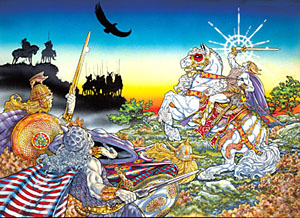
|
|
|
�Lugh the Il-Dana� � 1979, Jim Fitzpatrick. Lugh, the greatest of the kings of the Tuatha d�
Danann, was later deified as the god of life, light and civilization par excellence in Celtic myth.
|
The sons of Magog were consistently represented in the legends of
the ancient Irish as representing the power of life, light and civilization.
The Tuatha d� Danann, the gods of light par excellence in Irish myth and
legend, were worshipers of light and of the sun, whereas the wicked
Fomorians were portrayed as worshipers of the dark and of the moon.
Fortunately, the power of the Tuatha D� prevailed over the power of the
Fomorians, and for a time kept the sacred isle free of the darkness, death
and destruction that was the legacy of the sons of Gomer.

Though the Tuatha d� Danann had defeated the wicked Fomorians and
driven them from Ireland, they too were eventually displaced by another
group of Magogian descent, the Gaedelic Celts, or
�Gaels�, better known to Irish history as the
Milesians. All of the previous invaders, from the
Parthol�nians to the Tuatha d� Danann, had
descended from Aithechta, the youngest son of Magog, but the
Milesian Gaels, the last of the invaders recorded in the Lebor, were
actually the descendants of Baath, the eldest son of Magog � specifically,
from Gaidel Glas, their eponymous ancestor.7
Though the Lebor states that the Scythians were descended from
Baath, generally speaking all of the descendants of Magog who lived in
and around Central Asia are usually broadly classified as Scythians,
mostly because there are so few records from these highly nomadic peoples
to help us distinguish one tribe from another. However, we do have
one possible clue about the heritage of the Milesians � there was a
group of Scythians who lived in the region of Margiana8
(modern
Uzbekistan) known as the �Amyrgian Scythians� that are mentioned by
Herodotus.9 This of course matches perfectly the name of the Milesian
leader �Amergin�, forming a strong, though not definitive, clue as to the
exact origins of the Gaels.
As the rightful heir of Baath, the eldest son of Magog, Amergin and
his people had the right of rulership over all the other descendants of
Magog. Thus, when Amergin first stepped upon the shore of Ireland and
uttered �The Mystery�, he was not merely waxing poetic. Whether or
not he realized it, he was exercising his rights as the rightful ruler of the
house of Magog, which included rulership over not only the Tuatha d�
Danann, but also all of the previous invaders of the sacred isle.10 Thus
Amergin�s �magic� was superior to that of the Tuatha D�, as by birth he
had the divine right to rule Ireland.

But the Tuatha d� Danann initially refused to recognize the divine right
of the Milesians to rule Ireland, instead opting to defend their failing
rule over the sacred isle through force. Greatly compounding their error
was the fact that the Tuatha D�, once the champions of life, light and
civilization, had over the centuries become decadent and wicked,
descending to the same level of darkness and decay as had the
Fomorians. In fact, their corruption had become so
complete that they had turned to worshiping demons
and summoning spirits of darkness which, according
to the Lebor, they had caused to inhabit the bodies of an army of giants and other fell creatures that they had used to
fight against the Milesians.11
Though the Tuatha d� Danann had originally come to the sacred
isle as a force for life, light and civilization, they had abandoned their
ancient mandate and had fallen into the same wickedness of the
Fomorians whom they had formerly driven out. Now it was the
Milesians who held the moral high ground, fighting �the battle of Life�
against the now wicked and apparently unredeemable Tuatha d�
Danann, who had descended to the level of openly using demonic
forces to fight their battles. This of course, in a world where a God of
order and light rules the nations, could not stand, and so the Milesians
were sent by divine providence to break the power of the fallen Tuatha
d� Danann just as the Tuatha D� had been sent to break the power of
the Fomorians. In that light, it would appear that Ireland�s essential
function in history has been as a place of judgment, wherein the forces
of darkness and light have repeatedly fought to determine the destiny of
the West. It is here, in the sacred isle, where the ancient mystery play
of the battle between the forces of light and darkness, between civilization
and savagery, has repeated itself countless times in countless ways
over the millennia.

|
|
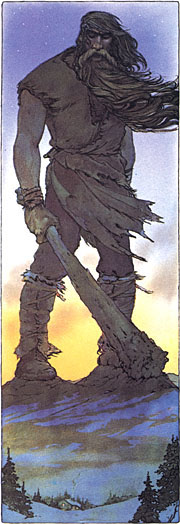
|
|
|
� 1979 Julek Heller
|
Giants are among the most common mythological beings to appear in
the myths and legends of the ancient world, and Ireland is no exception.
Numerous legends and folktales have a giant as the antagonist, the
hero of the tale being the man who defeats the wicked giant and
restores the community to order, whether by recapturing stolen treasure,
rescuing the damsel in distress, avenging a murder or simply ridding the
community of a source of fear that is keeping it from maintaining a
peaceful, ordered existence.
Most giants by far were ruthless, greedy, cannibalistic monsters that
thought only of their next plunder, or their next meal which, if cattle
were not available, could well be human flesh. Every giant had a special
sack that they carried with them wherever they went, so that they could
all the more easily take whatever their eyes fancied. The things they
loved to plunder the most were pretty, shiny things such as gold, silver,
jewelry, gems and/or fair maidens, particularly those with blonde or red
hair. And because of their exceptional size, strength, speed (some legends
around the world describe giants running down
deer and buffalo) and wicked intelligence, they usually
got their way, unless a hero was there to stop them.
However, though most
giants in the myths and legends
of ancient Ireland were rotten
to the core, many heroes of Irish
history, such as Nuada and Finn
McCool, were also gigantic in stature,
tall and powerful even by today�s
standards. Nuada, the descendant
of Iarbonel the giant was, like
all the royal line of Magog, exceptionally
large and strong, and also
manifested supernatural abilities.
Finn McCool, a giant of a man in
his own right, probably at least
seven feet tall, was an almost supernaturally
gifted athlete and warrior.
Over time Finn grew to be so large
and strong in the songs of the bards
that huge rock formations, primarily
in northeastern Ireland, were
often attributed to Finn�s failed
attempts to hit an opponent with a
boulder, the massive rock landing
dozens, even hundreds of miles
away. Another giant hero, Ois�n, as
we have seen, was shocked when
he returned from the Otherworld to
find that mankind had greatly
shrunk in size since the time of the
Fianna, indicating that not only
Ois�n, but all of the Fianna were
also gigantic in stature � the main
distinguishing
characteristic of
these men of renown.

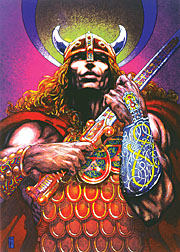
|
|
|
�Nuada of the Silver Arm�, � 1980, Jim Fitzpatrick.
|
|
Nuada Airgetl�mh, better known to
Irish history as �Nuada of the Silver
Arm�, is one of the most celebrated
figures of Irish history and myth. A
literal giant of a man, as the son of
Beothach, the son of Iarbonel the
son of Nemed, he was the rightful
heir of the line of Magog, and the
High King of the Tuatha d�
Danann, the fifth people to invade
Ireland. Nuada was a model for all
of the great Irish kings and heroes
for thousands of years.
Nuada made his first appearance
in Irish mythology in Cath Maige Tuired �The Battle of Moy
Tura�, the most important document
in the
Mythological Cycle of Irish legends. According to
the legend, his ancestor Beothach had led the Tuatha
d� Danann to the four cities of northern Europe after
their pyrrhic victory at Conan�s Tower. There they learned the
art of war in order to retake Ireland, which they did some time
later, under the leadership of Nuada.
Nuada first led the Tuatha d� Danann against the Fir Bolg in the
First Battle of Moy Tura, in which he first showed his exceptional skill,
strength and supernatural abilities. Nuada�s greatest power was his ability
to manifest the r�astrad, the �battle fury� or �warp spasm�, that was
essentially a berzerk fury similar to that of the later Viking berserkers,
where Nuada would fly into a rage and slaughter everything in sight,
heedless of his own safety. He also possessed the powerful Cla�mh Solais,
�The Sword of Light�, against which none could stand. Though Nuada
was unmarried, his lover was the M�rrigan, who protected him in battle
and also gave him counsel on war strategy. Near the end of the battle,
however, Nuada was confronted by Streng, the hero of the Fir Bolg
who, in single combat, managed to beat back the exhausted Nuada and
cut off his right, sword arm.
Thus mutilated, Nuada lost the kingship of the Tuatha d� Danann, as
their rules stated that their king could have no serious blemishes, and
Nuada fell into great sorrow and illness. However Dian C�cht, the great
healer of the Tuatha d� Danann, fashioned a silver arm for him that
worked even better than his original arm had. Thus restored, �Nuada of
the Silver Arm� was healed, body and soul, and returned to the kingship
of the Tuatha D�.
However, Nuada was limited in his ability to rule over the Tuatha d�
Danann due to the great power of the Fomorians, led by Balor of the Evil
Eye. He made his final appearance in The Second Battle of Moy
Tura, where he defeated the Fomorian general Indech, but was himself
killed by a powerful demon summoned by Balor. After his death, the
kingship over the Tuatha D� was taken over by Lugh.
Nuada also appears in various myths and legends, believed to have
been the consort of Boann under the psuedonym �Nechtan�. He was
also closely associated with the E�ganacht dynasty of Munster province,
to the point that the leaders of the clan had the alternate
title of Mug Duadat, �the servant of Nuada�.
Nuada�s burial place is believed to be at or near the
Grian�n of Aileach, in County Donegal.

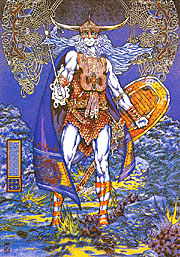
|
|
�The Coming of Lugh the Il-Dana�,
� 1979, Jim Fitzpatrick.
|
|
Lugh L�mfadha, (�Luke the
Long-Armed�) was another giant of the line of Iarbonel, the greatest
hero of the ancient Irish and the
central figure in the Irish Mythological
Cycle. Superceding Nuada
as High King of the Tuatha d�
Danann, he also superceded him in
the myths as the sun god par excellence,
his very name lugh meaning
�light�. Commentators also have
noted his many similarities with
the Roman god Mercury. His surname,
l�mfadha, �long-armed�, is
descriptive of his ability to hurl his
spear, the magical Sle� Bua, an
extraordinarily long distance. In
this way he was very similar to the
Hindu god Savitar, who was known
as �he of the wide hand�, more evidence that the Tuatha D� � and all of
the descendants of Magog � had originally emigrated from Central Asia.
Lugh was also known as Samild�nach, due to the fact that he was a
man of many skills, the art of war being the preeminent. He was also
known as �the Il-Dana�, from ild�nach, a word that indicates that he
may have also been a druid and/or poet of the highest order. Another
title he bore was Maicnia (�child-warrior�) due to the fact that the precocious
Lugh had become a warrior at a very early age.
Lugh encouraged Nuada to attack the Witch-King of the Fomorians, Balor of the Evil Eye, and free Ireland
from enslavement by the Fomorians, but Nuada was fearful and cautious about making war with the
powerful Balor and did nothing. Angered by Nuada�s lack of leadership,
Lugh killed a contingent of Fomorian tax collectors single-handedly,
ensuring Balor�s wrath. Nuada, however, upon hearing that the
Fomorians were attacking in retaliation, refused to defend the island,
instead telling Lugh that since he had killed the tax collectors, he could
now fight off the invasion by himself. Enraged at Nuada�s failure to
defend the hard fought freedoms of the Tuatha D�, Lugh effectively dismissed
him as king, and rode off to fight off the Fomorian invasion with
the help of his father Cian, Bobd Derg, and the Riders of the S�dhe.
After defeating the first invasion of the Fomorians, which turned out to be a diversion from the main invasion,
Lugh finally arrived at the main battle between the Tuatha D�
and the Fomorians several days later, by which time the battle had been
nearly lost to the Fomorians. Nuada had been killed by the Demon of
Death, and Balor was about to use his evil eye to destroy the D� Danann
army. Realizing the immediate peril to himself and to the Tuatha D�,
Lugh whipped out his magical spear, the Sle� Bua, and destroyed Balor�s
evil Eye with a single shot � perhaps the most famous single event in
Irish mythology. After the battle, Lugh was made the High King of the
Tuatha d� Danann, and ruled the land well for forty years. During this
time he instituted many traditions, including the Tailltiu Festival, in
honor of his foster mother. Though very long-lived, as were most giants,
Lugh�s reign was cut short when he was killed near the Hill of Uisneach
by Mac Cuill, Mac C�cht and Mac Gr�ine � the last three kings of the
Tuatha D� � in revenge for the killing of their father, Cermait.
After his death Lugh was deified by the people to the level of a major
deity, and is believed by some sources to have been buried at Newgrange.
As late as the early twentieth century, he was remembered every August
1 in the Lughnasa festival, when the ripening of crops is celebrated.
As such, he may have also had aspects of a fertility god. After the advent
of Christianity, however, though the festivals continued until relatively
recently, Lugh was replaced by St. Michael, who is remembered in the
Michaelmas festival, popular throughout Ireland and the British Isles.
Lugh was believed to have had at least four wives and several children,
and was also married to the sovereignty goddess
�riu, which was believed to be necessary in order to
be the true king of Ireland. Lugh�s most famous son
was the legendary C� Chulainn who, though not a giant, shared his father's exceptional, almost
supernatural, fighting skills.

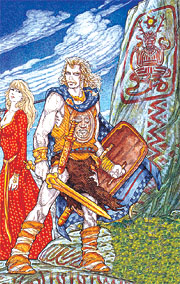
|
|
|
�Fionn MacCumhaill�, � 1993, Jim Fitzpatrick.
|
|
Fionn MacCumhail, or
�Finn McCool�, was a blonde
giant who had been born in
what is now County Meath
around the time of Christ into
the Clanna Baioscne of Leinster.
Finn displayed characteristics
of a hunter, warrior and seer in
the myths of the Fenian Cycle, wherein he was the head
of his clan and of the Fianna
�ireann, a military order based
in Leinster province. So
great was Finn�s fame that
countless myths, folktales and placenames around Ireland and the British
Isles still bear his name.
Finn had been born Demna M�el, a name that indicates that he may
have had associations with druidry and the Otherworld from an early age.
Not only was Finn exceptionally tall, strong, and charismatic, he was
extremely long-lived, remaining the leader of the Fianna until the latter
half of the third century AD when he died at the ripe old age of 230.
Finn had been raised in secrecy in order to protect him from his grandfather, who feared the prophecy that he would lose his throne to his grandson. After being safely raised in the wilderness by a druidess until he came of age, Finn desired to meet and play hurley with boys of his age. So he journeyed to Tara, the ancient capitol of Ireland, and along the way, he came upon a hurling match. Joining in, Finn easily
defeated the other boys at hurling and, when they set upon him in a jealous
rage, he easily defeated them in combat. The local chieftain, who had
been watching the game, asked, C� h� an giolla fionn? �Who is that fair
boy?�, the term �fair� referring to the color of his hair, which was apparently
a very light platinum blonde. It was from that time on that �Demna�
became known as �Finn�, as fionn means �fair� in Gaelic.
Finn continued on his journey to Tara, and after a time came to the
Well of Sergais, along the River Boyne. There he met Finnegas, a druid
who had been waiting by the well for seven years to catch The Salmon
of Knowledge, the flesh of which was said to give the
one who ate of it supreme wisdom. The Salmon, it
was believed, gained its knowledge from eating the
hazel nuts that fell into the wells on the sacred hills.
Finn, unlike Finnegas, easily caught the Salmon, which had
appeared to him suddenly, as if it was his destiny to have the
supreme wisdom. Furious, Finnegas ordered young Finn to roast it,
warning him that there must not be a single blister on the fish from the
cooking, or he would cut off Finn�s head. However, as The Salmon of
Knowledge was cooking, Finn noticed that a blister had started to erupt
on its skin, which Finn pushed down with his finger. His finger was of
course burned, and he placed it in his mouth to soothe the pain, taking
a piece of the Salmon of Knowledge with it. After Finn had swallowed
the morsel, Finnegas saw the light of wisdom shine forth from his eyes,
and he realized that Finn had received the gift of supreme wisdom.
|
|
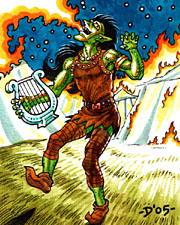
|
|
|
Aillen of the Flaming Breath was a powerful, evil fairy, or s�dhe, that came forth from the fairy mounds near Tara every Halloween and used his fiery breath to burn down the entire palace. He did this for many years until he was finally slain by the legendary giant Finn McCool.
Image � 2006 Mysterious World.
All Rights Reserved.
|
Finn eventually reached Tara and confronted King Conn of the
Hundred Battles, proclaiming his rights as the son of Cumhail, the former
head of the Fianna. Conn received him with gladness as an ally and placed
him in his service, seating him next to his own son, Art. It was then that
Finn learned of a great trouble that had come upon Tara � a goblin, one
of the s�dhe named Aillen of the Flaming Breath, had been destroying
Tara every Samhain eve (Halloween). Aillen came forth from the
Underworld on Halloween, as did the rest of the fairy host, according to
Celtic tradition. However, unlike the rest of the s�dhe, who contented
themselves with minor mischiefs, Aillen made it a point every year to burn
down the High King�s palace at Tara with great balls of fire that came forth
from his mouth. And no one, not even the Fianna, was able to stop him,
because before he came to destroy he played a song on his silver harp so
sweet that it placed all who heard it into a deep slumber. That year, Conn
had decided to offer to anyone who could stop the goblin from destroying
Tara, �whatever inheritance is right for him to have,� a challenge that
Finn, looking to make a name for himself, eagerly accepted.
Unsure of what to do, Finn was then helped by an aging
Fianna named Fiacha. Fiacha gave Finn a magic spear called The
Spear of Len that had been forged in the Otherworld, and advised Finn
to place the tip of the spear against his forehead when the goblin played
his music so as to ward off the magic. Finn did so, and only just managed,
with the power of the spear, to stay awake. Then, after quenching
the goblin�s fire with his magic cloak, Finn used his magic spear to
pierce Aillen through the heart, pinning him to a tree as he ran away.
Greatly pleased at finally being rid of the goblin, King Conn gave Finn
his choice of rewards. Finn chose to be given his rightful place as the chief
of the Fianna, and the king accepted, as did Goll Mac Morna, who had
been the leader of the Fianna since Cumhail�s death. Finn then led the
Fianna through many adventures, his leadership � which lasted the lifetimes
of three High Kings � marking the zenith of their fortunes.
In life, Finn�s residence was the Hill of Allen in County Kildare. He is
also sometimes linked to the Dinn R� in County Carlow, the Giant�s
Causeway in Country Antrim and numerous other structures, both in
Ireland and all around the British Isles.

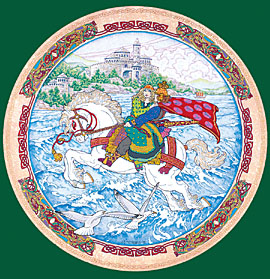
|
|
�Ois�n and Niamh�, � 1990, Jim Fitzpatrick.
|
Ois�n, also called �Ossian� in some contexts, was one of the greatest warriors
of the Fianna, and a great poet, so renowned in the Fenian mythology
that the Fenian Cycle is often referred to as �The Ossianic Cycle�.
Ois�n was the offspring of the union between Finn
McCool and the goddess Sadb, who had been transformed
into a fawn by an evil druid. One day Finn�s
hounds Bran and Sceoland chased Sadb back to their master, who lived on the Hill of Allen. As soon as Sadb reached
the protection of that magical hill, however, she was transformed
back into a beautiful woman. Taken with her beauty, Finn married her,
but she was later lured out of the protective circle of the hill by the evil
druid, transformed back into a fawn, and was never seen again. Seven
years later, however, Finn found a naked boy under a rowan tree on Ben
Bulben, a many-storied hill in County Sligo. This was Ois�n, and the boy
grew to be a powerful man and one of the
greatest of the Fianna.
Ois�n�s greatest claim to fame
is recounted in Laoi Ois�n id
T�r nan �g (�The Lay of
Ois�n in the Land of
Eternal Youth�). There
Ois�n, while hunting
one day with the
Fianna, was visited by
a beautiful fairy woman
named Niamh
Chinn �ir, �Neve of
the Golden Hair�, who
rode out from the
Underworld under the sea
on Aonvarr, the magical
horse of Manannan Mac Lir,
onto the land where Ois�n was
hunting. Niamh then declared
to the handsome young Ois�n
that she had been watching him for some time, had fallen in love with him,
and wanted him to return with her to the land of T�r nan �g to live together
in paradise forever. Naturally he agreed, and they proceeded with 300
years of blissful lovemaking, producing two sons � one named Oscar �
and a daughter. Lonely for his old friends, however, and
unaware in his bliss that 300 years had passed, Ois�n
decided to visit the Fianna. Niamh warned him to never
dismount Aonvarr and touch the ground, though,
knowing that if he did, time would immediately catch up with
him, and he would instantly wither and quickly die.
When Ois�n reached the headquarters of the Fianna on the Hill
of Allen, he was astonished to see how men had shrunk in stature and
had become weaker than the Fianna he had known, who had been literally
giants among men. But 300 years had passed and the Fianna had
come and gone, a reality with which Ois�n had yet to come to terms.
Seeing these lesser men straining to lift a stone that even the least of
the Fianna would be able to throw a mile with one hand, Ois�n literally
stooped to help them lift it. Unfortunately his stirrups broke
under the strain, and he fell to the ground, aging 300 years in an
instant.
Though some traditions have it that he died shortly thereafter of
extreme old age, others have Ois�n living on as an old man to argue the
virtues of the old ways with St. Patrick. These arguments became so popular that an enormous number
of variations sprang up between the 13th and 18th centuries. Ois�n�s
adventures are closely associated with the Hill of Allen, in County
Kildare, and numerous other related locations.

Besides the more famous giants Nuada, Lugh, Finn and Ossian, as well as the similarly famous Iarbonel and Fergus Mac Roich, there were also a number of other giants of lesser stature that populated the myths and legends of ancient Ireland. Here is a short list of some of the better known and generally villanous giants of ancient Ireland:
 �EDA
�EDA
�eda was an ugly male giant of the Fenian Cycle who romantically pursued
the beautiful giantess B�binn. Enraged at her rejection, he pursued
and eventually killed her.
 BEBINN
BEBINN
B�binn was a beautiful giantess of noble mien who asked the Fianna for
protection against the unwanted advances of �eda. Enraged at being
spurned, �eda broke into their palace and killed her.
 BACHLACH
BACHLACH
A bachlach was a form of giant troll, or �churl�, that usually worked as
a herdsman or other type of menial laborer. The wizard C� Roi
appeared in the tale �Briccriu�s Feast� as a bachlach in order to
diguise his true identity.
 GOLL MAC CARBADA
GOLL MAC CARBADA
Goll Mac Carbada was a huge, one-eyed giant who was the constant
enemy of C� Chulainn thoughout the Ulster Cycle, whom C� killed
in the end. Some scholars have noted that the conflict between C�
and Goll Mac Carbada may parallel the conflict between Lugh and
Balor, and between Finn McCool and Goll Mac Morna, the conflict
between hero and giant being a common motif in Irish myth.
 CIUDACH
CIUDACH
Ciudach was an amiable giant of good looks and disposition who hailed
from the region of Roscommon, Connaught province. In one legend,
while on the run with Diarmait, Gr�inne actually had an affair with
Ciudach, indicating that he must have been very amiable indeed. In
later stories, however, Ciudach appears to transform
into a dark, evil creature or spirit that haunts caves
and eats humans. The legend of the Ciudach actually appears to have extended across the western Celtic world,
appearing on the Isle of Man and even as far as Inverness in
Scotland.
 FACHTNA FATHACH
FACHTNA FATHACH
Fachtna F�thach was a wise, benevolent and civilized giant, the son of
Cathbad the druid. Fachtna was the king of Ulster and with his wife,
Ness, fathered the famous Conchobar Mac Nessa. After his death,
Fachtna�s brother Fergus Mac Roich married Ness and succeeded
Fachtna as king until Ness maneuvered Conchobar, the rightful heir,
into position as king.
 FER CAILLE
FER CAILLE
Fer Caille (lit., �man of the woods�) was the �churl�, or giant, trolllike,
herdsman figure, that makes a prominent appearance in the
influential myth, Togail Bruidne Da Derga, �The Destruction of Da
Derga�s Hostel�. Fer Caille is described as having only one eye,
one hand, and one foot, just like the Fomorian giants whom the
Parthol�nians had fought against. His hair is described as being very
long, hard and spiky, sticking straight up like the bristles on a boar�s
back, and so stiff and sharp that if one poured out a bucket of apples
onto his head, not a one would hit the ground. In the story he is
accompanied by an extraordinarily ugly woman, and carries a live boar
on his back for the main course in a feast. Fer Caille uses his magic to
entice Conaire, the hero of the story, into staying a while and joining
him in the feast, thus delaying him on his journey. The �churl� is an
interesting recurrent motif that appears occasionally in Irish myth,
introduced perhaps to inject the elements of danger and horror into
the storyline, and whose presence may indicate that the Fomorians
were never completely driven out of Ireland.
 INGCEL CAECH
INGCEL CAECH
Ingc�l Caech, (lit., �one-eyed�) was another one-eyed giant whose eye
was so huge that it was said to be as broad as an oxhide. His eye was
also unusual in that it had three pupils, and was as
black as a beetle.
Ingc�l was also a pirate who hailed either from Britain or Cornwall, frequently leading his band of giant pirates
to raid the coastlands of Ireland. Along with the sons of Donn D�sa
and the seven sons of Maeve (the �Maines�), Ingc�l Caech was responsible
for the destruction of Da Derga�s hostel in the tale of the same name.
 MIDCHAIN
MIDCHAIN
Midcha�n was a huge giant who lived in and protected a hill in northern
Lochlann (Scotland). He rarely needed to fight, as his voice was so
powerful and penetrating that he could actually kill men with a shout.
In the epic Oidheadh Chlainne Tuireann, �The Fate of the Children of
Tuireann�, Lugh sent the sons of Tuireann on a geas to fulfill their blood
money, part of the fulfillment of which involved being forced to endure
hearing three shouts from Midcha�n.
 MUIRCARTACH
MUIRCARTACH
Muircartach is the name of a monstrous, giant, evil sea hag of Irish and
Scottish folklore, related to the Cailleach Beara of County Cork. She is
hideously ugly, being bald with a black face and a single, huge eye protruding
out from her forehead. When she rises from her watery home,
she causes great storms, perhaps the basis of the �sea hag� myth that
superstitious sailors blame for causing sudden, powerful storms.
Occasionally she is seen in the myths as showing up at people�s doors in
the form of a dripping wet, pathetic old woman, begging for shelter. But
only the foolish would let her inside, as once she was inside, she would
swell up to her normal, huge size and wreak havoc. She could be friendly
sometimes, however, healing the sick or wounded with her pot of balsam,
and even raising the dead by poking her wizened finger into their
mouths.
 SEARBHAN
SEARBHAN
Searbhan was a solitary Fomorian giant who figured prominently in the
legend, �The Pursuit of Diarmait and Gr�inne�. Also known as
Lochlannach, �the Norseman�, he lived in the forest of Dubros, County
Sligo, where he protected the magical rowanberry trees with his powerful
magic. Unable to overcome his magic, Diarmait
ended up having to use the giant�s own magical club
to defeat him.

So we see our quest to solve the puzzle of Earth's giant heritage did not end with our four-part series on
Giants
published over three years ago, but continues on in our investigation of ancient Ireland,
Mysterious World: Ireland,
excerpts of which appeared in this article. Future books will further investigate the mysterious origins, legacy, and possible return of the giants in many other countries around the world, but for now we must leave the giants to their own devices and move on to more mysterious and legendary creatures of ancient Ireland. Tune in next quarter for our next installment in our series of mysterious creatures of Ireland.
To learn more about visiting Ireland and uncovering its giant legacy for yourself, see our article on
journeying to Ireland
in this issue, visit our Mysterious World: Ireland website at
ireland.mysteriousworld.com,
or pick up a copy of
Mysterious World: Ireland to learn the whole truth about what actually happened in our mysterious past, and gain insight into what will happen again in our future.
Gog, Prince of the West
|
Giants of Europe
|
The Coming War of Gog and Magog
Hunting for Giants
|
Giant Links
|
Books
|
Audio
|
Video
|
Posters
Editorial
|
Press Releases
|
Book Reviews
|
Fragments
Artifacts: The Exodus Revelation I
The Journey: Ireland I
|
Giants of Ireland
|
The Lord of the Rings Cipher I
Register
for our Hall of Records Newsletter
Questions? Comments? Suggestions? Advertising? Press Releases?
Contact us!

1
Silkroad Foundation, "The Scythians"
(Silkroad Foundation: http://www.silk-road.com).
The Scythians routinely raided the lands of the Bible. From 628-626 b.c., in one of their larger raids, the Scythians launched a prolonged raiding campaign throughout the Near East, making it as far south as Egypt. This had the effect of weakening the regional powers of Assyria and Egypt, leaving Judah as the strongest power in the region, so King Josiah had a free hand to destroy the foreign idols that had begun to supplant traditional Israelite religion and enact sweeping reforms (2 Chronicles 34).
2
R.A.S. Macalister, ed., Lebor G�bala �renn: Vol. I (London: The Irish Texts Society, 1941), 155-157. Magog is listed in Genesis 10, but his descendants are not. Unfortunately, there are several traditions interweaved into the Lebor with contradictory genealogies of the descendants of Magog, so the Lebor should not be taken as an authoritative document at the same level as the Bible. See
Mysterious World: Ireland, p. 23 for a geneological chart of the descendants of Magog.
3
Dr. Oric Basirov, �The Origin of the Pre-Iranian Peoples� (Circle of Ancient Iranian Studies
at the School of Oriental & African Studies (SOAS), University of London, or http://arizonapersian.com/iran/_disc4/0000075a.htm). Interestingly, the
Scythians tended to call themselves �Saka� or �Skita�, close to the term �Scot�, which until
recently was routinely used to describe the inhabitants of both Scotland and Ireland. For
more information on the Scythians, visit http://www.silk-road.com/artl/scythian.shtml.
For more information on the Taklamakan Mummies, visit
Mysterious World Journal: 2002: Fragments: WhiteMummies.
4
For more information on the origin and history of the giant sons
of Magog, see http://www.mysteriousworld.com/Journal/2003/Autumn/Giants/.
5
For more information on the history of the giant descendants of Gomer and their
later conflicts with Rome, see Part IV of our series on giants at http://www.mysteriousworld.com/Journal/2003/Winter/Giants/.
6
Marie-Louise Sjoestedt, Celtic Gods & Heroes (Mineola, NY: Dover Publications, 2000
[reprint of the 1949 edition]), 5-6. The reference to these men with one foot, one hand
and one eye may be literal. The Scythians were at one time at war with an Amazonian
tribe of female warriors who would actually remove a hand and/or leg from their male
children in order to keep them submissive. The Fomorian males who fought the
Parth�lonians might literally have had only one foot, one hand and one eye, but had
developed a fighting style that compensated for their mutilation. (Greek Mythology Link,
�Scythia� (http://homepage.mac.com/cparada/GML/Scythia.html)).
7
Macalister, Lebor G�bala �renn: Vol. I, 147.
8
Margiana is a region in Central Asia roughly corresponding to modern Uzbekistan and/or
Turkmenistan. For more information see http://www.livius.org/man-md/margiana/margiana.html.
9
For more information on the Scythians, see
http://www.livius.org/sao-sd/scythians/scythians.html
and
http://www.pakhtun.com/Sakas.htm
Herodotus is one of the few reliable
sources on the Scythians, and he divided them up into �4 main branches known as
the MassaGatae, Sacae, Alani, and Sarmatians, sharing a common language, ethnicity
and culture.� From G. Singh, �The Scythians � Sakas� (LeVanay�s Site:
http://www.pakhtun.com/Sakas.htm).
The �Alani� are the Alans, which most likely correspond
to Alainus, the son of Ibath. Singh corroborates the Central Asian origin of many
Europeans, pointing out that �A branch of the Sakas known as the Alani reached regions
of Europe, Asia Minor and the Middle East. They have been connected to the Goths of
France/Spain, Saxons and the Juts of Denmark.� This lends great weight to the theory
that the Celts, along with many other European peoples, originated from Central Asia in
ancient times, and also supports the geneology of the sons of Magog as described in the
Lebor.
10
Save of course the Cessair, all but one of whom, according to legend, had been wiped out
by Noah�s Flood.
11
R.A.S. Macalister, ed., Lebor G�bala �renn: Vol. V (London: The Irish Texts Society, 1941), 33-35.




 SilkRoad.com: Silk Road Chronology
SilkRoad.com: Silk Road Chronology

 Mysterious World: Ireland
Mysterious World: Ireland
Ian Middleton (Author), Douglas Elwell (Co-Author), Jim Fitzpatrick (Illustrator)
Rating:





Mysterious World: Ireland represents the next generation of travel guides. More than just a listing of names, numbers, and dates, Mysterious World: Ireland takes readers behind the scenes to help them understand the history and the mystery of this sacred isle. Mysterious World: Ireland delves deep into Ireland's legendary past, looking especially at the mysterious people who invaded Ireland time and time again in search of their destinies. MWI also covers Ireland's known history up to the present, providing a thorough understanding of what it is to be Irish. Take a journey with world traveler Ian Middleton on his quest to rediscover mysterious Ireland! (Review by Mysterious World)
Click
here
to buy this book.
 Celtic Gods and Heroes
Celtic Gods and Heroes
Marie-Louise Sjoestedt
Rating:





Marie-Louise Sjoestedt's 1940 classic "Celtic Gods and Heroes" (2000 English language edition) is a must read for every student of pre medieval western European folklore, religion, and mythology. This brief study (only 95 pages) concludes with a thorough 4-page bibliography and precision 4-page index.
Sjoestedt's central point with this original study is that students should not project contemporary understandings on ancient narrative. Indeed, much of her work simply wants to report on the pre Roman Celtic cultures of Ireland, Britain, and Gaul.
Sjoestedt is impressive and informative. She is recommended to students of European pre-history, connoisseurs of mythological studies, and Celtic aficionados. (Review by Amazon.com)
Click
here
to buy this book.
 Giants
Giants
David Larkin, Julek Heller (Illustrator)
Rating: 




Giants is a classic popular reference work on the subject of giants in myth and history, and is also an enjoyable read on its own. Filled with lavish, cleverly rendered illustrations, it makes an excellent general reference book and even a good coffee table book. (Review by Mysterious World)
Click
here
to buy this book.
 Genesis 6 Giants
Genesis 6 Giants
Stephen Quayle
Rating: 



Genesis 6 Giants provides a good, solid overview of giants in religion, myth and history, and also serves as a good reference for other sources on giants. Quayle also adds his own insights into the mix, providing some interesting and thought-provoking reading. He also offers several other books on related topics on his website,
http://www.stevequayle.com.
(Review by Mysterious World)
Click
here
to buy this book.
 Giants: A Reference Guide from History, the Bible, and Recorded Legend
Giants: A Reference Guide from History, the Bible, and Recorded Legend
Charles DeLoach
Rating:




A standard reference book for giants throughout history, DeLoach's classic work is the result of years of painstaking research. Books of this type are becoming increasingly rare, but fortunately, DeLoach's Giants is still in print, or else much important information on this subject would be lost, or very difficult to find. (Review by Mysterious World)
Click
here
to buy this book.
 The World of the Celts
The World of the Celts
Simon James
Rating:





"The whole race... is madly fond of war, high-spirited and quick to battle... and on whatever pretext you stir them up, you will have them ready to face danger, even if they have nothing on their own side but their own strength and courage" - Strabo, first century BC. Warlike, flamboyant, courageous - the ancient Celts had a fearsome reputation, even among the bellicose Romans. For 500 years they dominated the barbarian lands north of the Alps, before being largely absorbed into the Roman Empire. But Celtic culture survived and achieved a glorious flowering in the post-Roman, early Christian era. Today Celtic influence can be found everywhere, in arts and crafts, in legends, in placenames and even in the languages we speak. In this new introduction to the world of the Celts, Simon James looks at all aspects of their history. Individual sections chart their rise, their way of life from farming to feasting, their wars, their gods, and their superb craftsmanship. Also highlighted are the hitherto neglected subject of Celtic life under Roman rule and persistent traditions that led to the Celtic renaissance in Ireland after AD 400. Original features include the latest discoveries; extracts from classical authors; illustrated retellings of the most famous myths and legends; tables of comparative information; diagrams, maps and site plans. The Celts once held sway over much of Europe, from Caledonia to Asia Minor. Here is the whole story of this immensely inventive and influential people. (Review by Amazon.com)
Click
here
to buy this book.
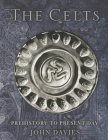 The Celts
The Celts
John Davies
Rating:




This is an account of the Celtic peoples exploring the cultural, archaeological and historical evidence for their origins, development and heritage. From their heyday to their defeat by the Romans, from their adoption of Christianity to the flourishing of the Celtic church. The span of this exploration extends from prehistoric Europe to near-obliteration to a new self-assertion as we enter a new millennium.
(Review by Amazon.co.uk)
Click
here
to buy this book.
 Celtic Warrior (Men at Arms Series, 30)
Celtic Warrior (Men at Arms Series, 30)
Stephen Allen
Rating:




In the 1st Century BC, Strabo wrote of the Celts: 'The whole race...is madly fond of war, high -spirited and quick to battle...and on whatever pretext you stir them up, you will have them ready to face danger, even if they have nothing on their side but their own strength and courage'. This book gives an insight into the life of the Celtic warrior, and his experience of battle - on fact, on horseback, and as a charioteer. It also details Celtic society and studies the vital ritual nature of Celtic warfare, from the naked gaesatae to the woad-painted warriors.
(Review by Amazon.com)
Click
here
to buy this book.
 Archaeology and Language: The Puzzle of Indo-European Origins
Archaeology and Language: The Puzzle of Indo-European Origins
Colin Renfrew
Rating:





In this book Colin Renfrew directs remarkable new light on the links between archaeology and language, looking specifically at the puzzling similarities that are apparent across the Indo-European family of ancient languages, from Anatolia and Ancient Persia, across Europe and the Indian subcontinent, to regions as remote as Sinkiang in China. Professor Renfrew initiates an original synthesis between modern historical linguistics and the new archaeology of cultural process, boldly proclaiming that it is time to reconsider questions of language origins and what they imply about ethnic affiliation--issues seriously discredited by the racial theorists of the 1920s and 1930s and, as a result, largely neglected since. Challenging many familiar beliefs, he comes to a new and persuasive conclusion: that primitive forms of the Indo-European language were spoken across Europe some thousands of years earlier than has previously been assumed. There was, in particular, no "coming of the Celts", but rather a parallel development of Celtic-speaking peoples in much the same areas in which they are found today.
(Review by Amazon.com)
Click
here
to buy this book.
 In Search of the Indo-Europeans: Language, Archaeology, and Myth
In Search of the Indo-Europeans: Language, Archaeology, and Myth
J. P. Mallory
Rating:





What image do the Indo-Europeans conjure up? For many, it is one of horse-riding warriors sweeping out of Asia, spreading their languages and culture with each clash of the sword. Certainly, linguistic history shows that most of the peoples of Europe, Iran and India share a common ancient language known as Proto-Indo-European. Celts, Germans, Italians, Greeks, Albanians, Slavs, Indians and many peoples long extinct can all have their linguistic ancestry traced back to this mother tongue. But how far does the story told by languages match the historical and archaeological record? What do we know about the lives and beliefs of these early Indo-Europeans? And where was their original homeland? With the skill of a forensic scientist Dr. Mallory traces the immediate origins of each of the Indo-European peoples of Europe and Asia. By comparing their languages he demonstrates their common cultural heritage, and through the technique of comparative mythology he examines their earliest beliefs. Then he puts the case for their most likely homeland and presents the archaeological and linguistic evidence for their expansion across Europe and Asia, a process that has in recent times carried Indo-European speakers to every corner of the world. Accompanied by extensive quotations from translated texts and fully illustrated with maps, diagrams and photographs, In Search of the Indo-Europeans is recognized as the standard work in its field.
(Review from the back cover)
Click
here
to buy this book.
 Update on the Aryan Invasion Debate
Update on the Aryan Invasion Debate
Koenraad Elst
Rating:





The author shows profound knowledge of the highly political debate on the Aryan Invasion theory. Though the Aryan Invasion Theory is untenable based on current data he urges the revisionist scholars to answer some of the valid concerns about the Indian Urheimat Theory (IUT). He laments on the deafness and over confidance of the scholars in each camp. There is a good discussion of the linguistic issues for the uninitiated. The book draws the reader in right from the first page and is hard to put down. (Review by Amazon.com)
Click
here
to buy this book.
 Genes, Peoples, and Languages
Genes, Peoples, and Languages
Luigi Luca Cavalli-Sforza, Mark Seielstad
Rating:





Luigi Luca Cavalli-Sforza was among the first to ask whether the genes of modern populations contain a historical record of the human species. Cavalli-Sforza and others have answered this question-anticipated by Darwin-with a decisive yes. Genes, Peoples, and Languages comprises five lectures that serve as a summation of the author's work over several decades, the goal of which has been nothing less than tracking the past hundred thousand years of human evolution.
Cavalli-Sforza raises questions that have serious political, social, and scientific import: When and where did we evolve? How have human societies spread across the continents? How have cultural innovations affected the growth and spread of populations? What is the connection between genes and languages? Always provocative and often astonishing, Cavalli-Sforza explains why there is no genetic basis for racial classification.
(Review by Amazon.com)
Click
here

 Music of Celtic Legends: The Bard & The Warrior
Music of Celtic Legends: The Bard & The Warrior
Brian Dunning, Jeff Johnson
Rating:





Two of the most important figures of Celtic legend are Taliesin, the bard and Cu Chulainn, the warrior. Their deeds, remembered and recorded by the monks of Britain and Ireland, have been handed down to us as a legacy of a now-vanished world. Celtic Legends is a mesmerizing blend of musical magic from Jeff Johnson and Brian Dunning — a soundtrack inspired from two ancient tales of Celtic adventure written by best-selling fantasy author Stephen Lawhead.
(From the back cover)
Click
here
to buy this CD.
 The Celtic Circle: Legendary Music from a Mystic World
The Celtic Circle: Legendary Music from a Mystic World
Various Artists
Rating:





The Celtic Circle is probably the best compilation of contemporary Irish Celtic and related music available. I say "and related" as this two-album set covers a wide field of artists, from the cutting-edge sounds of the Corrs to the otherworldly ambience of Vangelis. And though the majority of the artists are Celtic (a broad term encompassing both Ireland, Scotland, Wales, and parts of England) in background, the sound and feel of this album reflects more the top branches of the Celtic tree of musical tradition, rather than the roots. That said, this is probably my favorite Irish/Celtic album because it is more modern and accessible, and the quality of the performances throughout are excellent, from a collection of many of my favorite contemporary artists. Moreover, though some of the tracks have little directly to do with the Celts (such as the tracks from Lord of the Rings and the Harry Potter films), they still fit in fairly well as these soundtracks were largely inspired by Western/Celtic themes and musical traditions, being a fusion of Celtic and classical that resulted in a very satisfying sonic fusion of traditional and modern. Purists will (and have) written off this album as shallow and puerile, but the music speaks for itself. Followers of Mysterious World may notice that we have given very few albums five stars (or swords, in this case), so our five-star rating of The Celtic Circle should speak for itself. This album evokes a strong, mystical feeling of Celtica in me, and since the evocation of the spirits of elder times is the purpose of all good music, this album is recommended as your primary listening when reading Mysterious World: Ireland.
(Review by Mysterious World)
Click
here
to buy this CD.
 The Celtic Circle II: More Legendary Music from a Mystic World
The Celtic Circle II: More Legendary Music from a Mystic World
Various Artists
Rating:





The Celtic Circle 2 is a great followup to the first album, The Celtic Circle (see above, review). This album contains some more traditional songs, some sung in Gaelic, but it doesn't fail to nod to modern Celtic and related artists, with an endearing cut from Sting singing Mo Ghile Mear with The Chieftains. Another great album in a great series, hopefully they will create more like these as they are a great way to introduce a broad variety of Celtic artists and musical traditions to a broader audience. This album is also recommended as primary listening when reading Mysterious World: Ireland.
(Review by Mysterious World)
Click
here
to buy this CD.

 Mysterious Origins of Man: Rewriting Man's History
Mysterious Origins of Man: Rewriting Man's History
(1999)
Rating:




On February 25, 1996 NBC aired a one-hour prime-time special, The Mysterious Origins of Man, hosted by Charlton Heston. Controversy exploded in the academic community following this telecast. Much of the material for the program was taken from Forbidden Archeology, featuring interviews with co-authors Michael Cremo and Richard Thompson on the show. This DVD provides explosive evidence of man's true history, a history that academics don't want you to know about.
(Review by Mysterious World)
Click
here
to buy this DVD.
 The Celts - Rich Traditions & Ancient Myths
The Celts - Rich Traditions & Ancient Myths
(1987)
Rating:




The Celts gave Enya her first popular showcase, but there's far more to this epic documentary series than lushly ethereal music. Produced by BBC Scotland in 1987, the six-part, six-hour series shows its age with simple graphics and visual design, but writer-narrator Frank Delaney compensates with thorough scholarship and engaging presentation. "The Man with the Golden Shoes" begins with the Celts' earliest origins in Austria, studying burial remains to reveal a fiercely independent people, driven to expansion and exploration but failing to unite against the dominant forces of Rome. Subsequent episodes follow a categorical approach to Celtic history: "The Rise of Nations" in the British Isles leads to Celtic strongholds in Wales, Scotland, Ireland, and Brittany; "A Pagan Trinity" surveys Celtic mythology and the transition (through cultural cross-pollination) from Druid priesthoods to Celtic-influenced Christian missionaries; "The Open-Ended Curve" illuminates the development of Celtic art, music, and literature; "The Final Conflict" explores the fading, and subsequent revival, of Celtic languages, and how this history is reflected in present-day (and often erroneous) definitions of "Celtic"; and "The Legacy" examines the tenacious efforts to preserve Celtic language and culture in modern society.
(Review by Amazon.com)
Click
here
to buy this DVD.
 Nova: Mysterious Mummies of China
Nova: Mysterious Mummies of China
(1998)
Rating:




Perfectly preserved 3000-year-old mummies have been unearthed in a remote Chinese desert, shedding new light on the contact between the East and West in the ancient world. But these don't appear to be the ancestors of the modern-day Chinese people, they have long, blonde hair and blue eyes. New evidence of the lost civilization of the Tocharians along the Silk Road offers more clues to this mystery from the past.
(Review by Amazon.com)
Click
here
to buy this video.


 Ireland - The Giant's Causeway
Ireland - The Giant's Causeway
Size: 13 in x 38 in
Rating:




The world-famous Giant's Causeway, located on the northern coast of Ireland. The causeway, a mass of hexagonal columns created by rapidly cooling volcanic basalt, the causeway has been a prominent part of Irish myth and legend for thousands of years. (Review by Mysterious World)
Click
here
to buy this poster.
Editorial
|
Press Releases
|
Book Reviews
|
Fragments
Artifacts: The Exodus Revelation I
The Journey: Ireland I
|
Giants of Ireland
|
The Lord of the Rings Cipher I
Register
for our Hall of Records Newsletter
Questions? Comments? Suggestions? Advertising? Press Releases?
Contact us!
|
